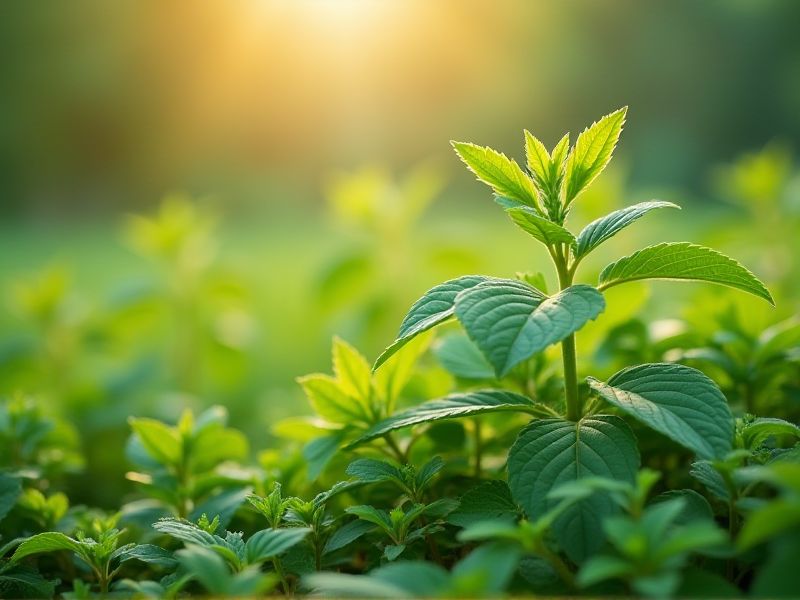
Herbal plants such as chamomile, peppermint, and hibiscus can significantly enhance the flavor and health benefits of your teas. Chamomile is renowned for its calming properties, making it an excellent choice for evening relaxation. Peppermint adds a refreshing zest, known to aid digestion and invigorate the senses. Hibiscus contributes a vibrant crimson color and a tart flavor, rich in antioxidants that support cardiovascular health. Incorporating these herbal plants in your teas not only elevates taste but also promotes well-being through their unique medicinal properties.
List of some Herbal plants that enhance teas
- Peppermint (Mentha piperita)
- Chamomile (Matricaria chamomilla)
- Lemongrass (Cymbopogon citratus)
- Lemon Balm (Melissa officinalis)
- Hibiscus (Hibiscus sabdariffa)
- Lavender (Lavandula angustifolia)
- Ginger (Zingiber officinale)
- Rose Hip (Rosa canina)
- Spearmint (Mentha spicata)
- Echinacea (Echinacea purpurea)
Important things about Herbal plants that enhance teas
Flavor Profiles
Herbal plants such as chamomile and peppermint significantly enhance tea flavor profiles, offering distinct aromatic and taste experiences. Chamomile, known for its delicate, floral notes, provides calming properties that are perfect for soothing evening rituals. In contrast, peppermint introduces a refreshing, invigorating taste, making it ideal for revitalizing brews during the day. Incorporating these herbs not only elevates your tea's sensory appeal but also adds potential health benefits, like improved digestion and relaxation.
Health Benefits
Herbal plants such as chamomile, peppermint, and hibiscus not only add distinct flavors to teas but also offer numerous health benefits. Chamomile is renowned for its calming properties, aiding sleep and reducing anxiety. Peppermint, with its refreshing taste, helps alleviate digestive issues and enhances focus. Hibiscus tea is rich in antioxidants and can support heart health by lowering blood pressure, making these herbal infusions a delightful addition to your wellness routine.
Preparation Methods
Herbal plants such as chamomile, peppermint, and hibiscus are commonly used to enhance teas, offering unique flavors and health benefits. To prepare herbal teas, you can steep dried leaves, flowers, or roots in hot water for optimal infusion; typically, a steeping time of 5 to 10 minutes is recommended. For a more concentrated brew, consider boiling the herbs in water before straining. By experimenting with combinations of different herbal plants, you can create a personalized tea blend that caters to your taste preferences and wellness goals.
Types Of Herbal Plants
Herbal plants such as peppermint, chamomile, and hibiscus are popular choices for enhancing teas, providing unique flavors and numerous health benefits. Peppermint is renowned for its refreshing aroma and digestive properties, making it a perfect addition to soothing herbal blends. Chamomile offers calming effects, often aiding in relaxation and sleep, which makes it a staple in evening teas. Hibiscus, with its vibrant color and tart flavor, is rich in antioxidants, contributing to both taste and health enhancements in your tea experience.
Growing Conditions
Herbal plants that enhance teas thrive in well-drained soil and require adequate sunlight, making a south-facing garden bed ideal for growth. Varieties such as chamomile, mint, and lemon balm flourish in temperate climates, benefiting from consistent moisture without waterlogging. Cultivating these herbs requires attention to seasonal changes, as they are often best harvested just before flowering for peak flavor and potency. You can explore companion planting with herbs like basil or rosemary to create a diverse and thriving herbal ecosystem in your tea garden.
Harvesting Techniques
Harvesting herbal plants for tea involves timing and methods that maximize flavor and potency. Generally, the best time to harvest leaves is early morning after the dew has dried, ensuring optimal essential oil concentrations. You should use sharp, clean tools to snip stems, allowing the plant to continue growing while preventing damage. After harvesting, gently air-dry the leaves in a shaded, well-ventilated area to preserve their aromatic properties and prevent mold, maximizing the quality of your herbal teas.
Drying Processes
Drying herbal plants is a critical process that preserves the flavor and potency of your favorite teas. Techniques such as air drying, oven drying, and using a dehydrator help maintain essential oils and active compounds, enhancing the overall health benefits of the herbs. For optimal results, ensure the herbs are harvested during peak growing seasons, as this maximizes their flavor and medicinal properties. Properly dried herbs can improve the aroma and taste of your teas, creating a more enjoyable drinking experience.
Storage Recommendations
For optimal storage of herbal plants that enhance teas, it's best to keep them in a cool, dark place to preserve their flavor and potency. Use airtight containers, such as glass jars, to prevent moisture and light exposure, which can degrade the quality of the herbs over time. Dried herbs, like chamomile or peppermint, should be labeled with their harvest date and stored away from heat sources like stoves or sunny windowsills. Regularly check your herbal stock, discarding any that show signs of discoloration or loss of fragrance to ensure the best possible tea experience.
Common Blends
Herbal blends that enhance teas often include ingredients like chamomile, peppermint, and lemongrass, each providing distinct flavors and health benefits. Chamomile is renowned for its calming properties, making it perfect for evening relaxation. Peppermint adds a refreshing zing, known to aid digestion and invigorate the senses. Lemongrass not only imparts a citrusy aroma but also boasts antioxidant properties, contributing to overall wellness in your tea blends.
Caffeine Content
Herbal teas often provide a caffeine-free alternative to traditional beverages, appealing to those seeking a calming experience without the stimulating effects of caffeine. Popular herbal plants like chamomile, peppermint, and rooibos are naturally caffeine-free and can enhance flavor profiles while offering various health benefits. For an energizing herbal option, consider ginseng or yerba mate, which can provide a mild stimulant effect similar to that of caffeine but with additional nutrients. By choosing the right herbal plants, you can create a satisfying tea infusion that aligns with your wellness goals and personal preferences.
